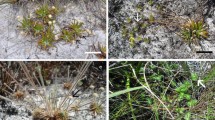Summary
Seasonal excavations of ramet systems in overlapping natural populations of Typha latifolia and T. angustifolia revealed intrapopulation variation in ramet size and reproduction. Reproductive “states” were recognized based on whether or not a ramet had flowered and the number of offspring ramets it possessed. As the growing season progressed, the populations became increasingly heterogeneous in their reproductive-state composition with the largest size classes of ramets containing the greatest number of reproductive states. Therefore, despite a strong correlation between size and reproduction, average ramet size was considered to be an inadequate predictor of population growth in ramet numbers. Results for vegetative reproduction and ramet mortality indicate that the T. latifolia population was growing while the T. angustifolia population was approximately stable. In contrast to most results reported for other species, the frequency distributions of ramet size classes showed T. angustifolia to have a normally distributed population. A slight degree of positive skewing occurred in T. latifolia with the greatest skewing at the end of the growing season. Despite the lack of strong skewing of ramet weights, evidence from other sources have demonstrated that competition was intense and we hypothesize that competition in clonal populations may not not always act to cause positive skew in weight distributions.
Similar content being viewed by others
References
Abrahamson WG, Gadgil M (1973) Growth form and reproductive effort in goldenrods (Solidago, Compositae). Amer Nat 107:651–661
Al-Mufti MM, Sydes CL, Furness SB, Grime JP, Band SR (1977) A quantitative analysis of shoot phenology and dominance in herbaceous vegetation. J Ecol 65:759–791
Callaghan TV, Collins NJ (1976) Strategies of growth and population dynamics of tundra plants. Oikos 27:383–388
Ford EB (1975) Competition and stand structure in some even-aged plant monocultures. J Ecol 63:311–333
Gadgil M, Solbrig OT (1972) The concept of r- and K-selection: evidence from wild flowers and some theoretical considerations. Amer Nat 106:14–31
Gottlieb LD (1977) Genotypic similarity of large and small individuals in a natural population of the annual plant Stephanomeria exigua spp. coronaria (Compositae). J Ecol 65:127–134
Grace JB, Wetzel RG (1981a) Habitat partitioning and competitive displacement in cattails (Typha): Experimental field studies. Amer Nat 118:463–474
Grace JB, Wetzel RB (1981b) Phenotypic and genotypic components of growth and reproduction in Typha latifolia: Experimental studies in marshes of differing successional maturity. Ecology 62:789–801
Grace JB, Wetzel RG (1981c) Effects of size and growth rate on vegetative reproduction in Typha. Oecologia (Berl) 50:158–161
Grace JB, Wetzel RG (1982) Niche differentiation between two rhizomatous plant species. Typha latifolia and Typha angustifolia. Can J Bot (in press)
Grime JP (1979) Plant Strategies and Vegetation Processes. John Wiley and Sons Publ, New York
Harper JL (1969) A Darwinian approach to plant ecology. J Ecol 55:247–270
Harper JL (1977) Population Biology of Plants. Academic Press, New York
Harper JL, White J (1974) The demography of plants. Ann Rev Ecol Syst 5:419–463
Hartshorn GS (1975) A matrix model of tree population dynamics. Tropical Ecological Systems: Trend in Terrestrial and Aquatic Research. FB Golley, E Median (eds) Springer, Berlin Heidelberg New York, pp 41–51
Hickman JC (1975) Environmental unpredictability and plastic energy allocation strategies in the annual Polygonum cascadense (Polygonaceae). J Ecol 63:689–701
Hotchkiss N, Dozier HL (1949) Taxonomy and distribution of N. American cat-tails. Amer Midl Nat 41:237–254
Hutchings MJ (1979) Weight-density relationships in ramet populations of clonal perennial herbs, with special reference to the-3/2 power law. J Ecol 67:21–33
Kawano S (1975) The productive and reproductive biology of flowering plants. II. The concept of life history strategy in plants. J Coll Liberal Arts, Tokyo Univ Japan 8:51–86
Koyama H, Kira T (1956) Intraspecific competition among higher plants. VIII. Frequency distribution of individual plant weight as affected by the interactions between plants. J Inst Polytech Osaka City Univ Ser D 7:73–94
Mack RN, Harper JL (1977) Interference in dune annuals: spatial pattern and neighborhood effects. J Ecol 65:345–363
McNaughton SJ (1968) Autotoxic feedback in regulation of Typha population. Ecology 49:367–369
McNaughton SJ (1975) r- and K- selection in Typha. Amer Nat 109:251–261
Naylor RL (1976) Changes in the structure of plant populations. J Appl Ecol 13:513–521
Noble JC, Bell AD, Harper JL (1979) The population of biology of plants with clonal growth. I. The morphology and structural demography of Carex arenaria. J Ecol 67:983–1008
Obeid M, Machin D, Harper JL (1967) Influence of density on plant to plant variation in Fiber Flax, Linum usitatissimum L. Crop Sci 71:471–473
Rabotnov TA (1975) The study of coenotic populations for the purpose of clucidating life history strategies of plant species. Bull Moscow Soc Nat Bio Dept 80:5–17
Regehr DL, Bazzaz FA (1979) The population dynamics of Erigeron canadensis, a successional winter annual. J Ecol 67:923–933
Sarukhan J, Gadgil M (1974) Studies on plant demography: Ranuculus repens L., R. bulbosus L. and R. acris L. III. A mathematical model incorporating multiple modes of reproduction. J Ecol 62:921–936
Sokal RR, Rohlf FJ (1969) Biometry. W.H. Freeman and Co, San Francisco
Stearns SC (1976) Life-history tactics: A review of the ideas. Quart Rev Biol 51:3–47
Stearns SC (1977) The evolution of life history traits: A critique of the theory and a review of the data. Ann Rev Ecol Syst 8:145–171
Werner PA (1975) Predictions of fate from rosette size in teasel, Dipsacus fullonum L. Oecologia (Berl) 20:197–201
Werner PA, Caswell H (1977) Population growth rates and age versus stage-distribution models for teasel (Dipsacus sylvestris Huds.). Ecology 58:1103–1111
Zaugolnova LB (1974) The development of clones and some features of the spatial structure of coenopopulations of Potentialla glaucenscens Willd. Ex. Schlecht. Bot Journal 59:1302–1310
Author information
Authors and Affiliations
Rights and permissions
About this article
Cite this article
Grace, J.B., Wetzel, R.G. Variations in growth and reproduction within populations of two rhizomatous plant species: Typha latifolia and Typha angustifolia . Oecologia 53, 258–263 (1982). https://doi.org/10.1007/BF00545674
Received:
Issue Date:
DOI: https://doi.org/10.1007/BF00545674




